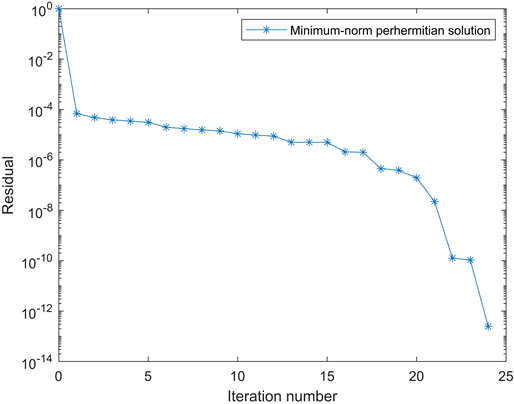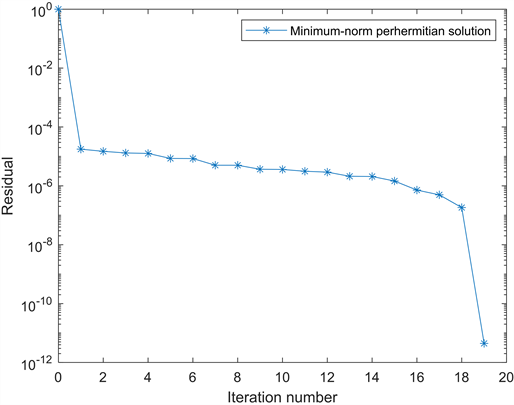Advances in Applied Mathematics
Vol.
12
No.
12
(
2023
), Article ID:
76957
,
20
pages
10.12677/AAM.2023.1212489
BiCR算法求解Sylvester矩阵方程组的Perhermitian解
唐孝伟*,李胜坤
成都信息工程大学应用数学学院,四川 成都
收稿日期:2023年11月7日;录用日期:2023年12月1日;发布日期:2023年12月12日

摘要
对于给定的矩阵
,如果
,其中S是给定的反射矩阵,即
,
,则称矩阵X为perhermitian矩阵。本文提出一种用于求解Sylvester矩阵方程组的perhermitian解的双共轭残差(BiCR)算法,并且证明了该算法的收敛性。通过选择任意初始perhermitian矩阵,可以在有限步求解出Sylvester矩阵方程组的唯一最小范数perhermitian解。最后,我们给出了一些数值算例来验证该算法的有效性和可行性。
关键词
Sylvester矩阵方程组,BiCR算法,Perhermitian解,最小范数Perhermitian解

The BiCR Algorithm for Solving the Perhermitian Solutions of Sylvester Matrix Equations
Xiaowei Tang*, Shengkun Li
College of Applied Mathematics, Chengdu University of Information Technology, Chengdu Sichuan
Received: Nov. 7th, 2023; accepted: Dec. 1st, 2023; published: Dec. 12th, 2023

ABSTRACT
For a given matrix
, matrix X is said to be perhermitian if
, where S is a given reflection matrix, i.e.,
,
. In this paper, we propose the Bi-Conjugate Residual (BiCR) algorithm for solving the perhermitian solutions of Sylvester matrix equations and prove the convergence of the algorithm. By choosing any initial perhermitian matrices, the unique minimum-norm perhermitian solutions of the Sylvester matrix equations can be solved in finite steps. Finally, we give some numerical examples to verify the validity and feasibility of the algorithm.
Keywords:Sylvester Matrix Equations, BiCR Algorithm, Perhermitian Solution, Minimum-Norm Perhermitian Solution

Copyright © 2023 by author(s) and Hans Publishers Inc.
This work is licensed under the Creative Commons Attribution International License (CC BY 4.0).
http://creativecommons.org/licenses/by/4.0/


1. 引言
矩阵方程在控制理论 [1] 、系统理论 [2] 和应用数学 [3] 等许多领域都有重要的作用,比如Sylvester矩阵方程可以用来恢复缺失或者损坏的信号或图像 [4] ,也可以用来研究线性时不变系统的稳定性 [5] 。另外,五点差分格式求解椭圆方程时会遇到Sylvester矩阵方程 [6] ,在常微分方程定性理论研究及数值求解的隐式Runge-Kwutta方法与块方法也会涉及到Sylvester矩阵方程 [6] 。对于它的一般解,基于Arnoldi过程,Hu等人 [7] 给出了求解
的Galerkin算法和最小残差法(MINRES);基于块Arnoldi过程,El Guennouni A等人 [8] 给出了求解
的块GMRES方法(BGMRES);为了提高收敛速度和缩短运算时间,基于全局Arnoldi过程,Fatemeh Panjeh Ali Beika等人 [9] 提出了求解Sylvester矩阵方程组的全局完全正交化方法(Gl-FOM)和全局极小残量法(Gl-GMRES)。由于Krylov子空间方法的收敛速度依赖于方程系数矩阵谱的性质,选取合适的预条件矩阵,往往可以提高收敛速度,为了进一步提高算法的收敛速度,Bouhamidi A等人 [10] 给出了预条件块Arnoldi方法求解Sylvester矩阵方程,Kaabi [11] 等人提出了预条件Galerkin算法(PGal)和预条件最小残差法(PMR)求解Sylvester矩阵方程。基于预条件全局Arnoldi过程,徐冬梅等人 [12] 给出了求解Sylvester矩阵方程组的预条件全局正交化方法(PG-FOM)和预条件全局极小残量法(PG-GMRES)。对于约束解,Dehghan和Hajarian [13] [14] 提出了求解广义Sylvester矩阵方程组的自反解和广义双对称解的CGNE方法。Dehghan和Hajarian [15] [16] 也通过推广CGNE方法得到了一般矩阵方程组的解和广义双对称解。但是,一般情况下,CGNE方法收敛速度较慢。最近,吕长青等人 [17] 和Masoud Hajarian [18] 提出了利用BiCR算法求解广义Sylvester矩阵方程组的中心对称解和反中心对称解,证明了这种BiCR算法可以在有限步内找到广义Sylvester矩阵方程组的中心对称解,并且选取特定的初始矩阵,可以得到最小范数解;闫同新等人 [19] 提出了利用BiCR算法求解广义Sylvester矩阵方程组的自反解和反自反解以及最小Frobenius范数对称解;Masoud Hajarian [18] 提出了利用BiCR算法求解广义Sylvester矩阵方程组的对称解,收敛性分析表明,BiCR算法在不存在舍入误差的情况下,可以在有限次迭代内计算出广义Sylvester矩阵方程组的最小Frobenius范数对称解对。然而,Sylvester矩阵方程组的perhermitian解目前还没有被研究过。因此,本文将给出求解Sylvester矩阵方程组的perhermitian解的BiCR算法。
在本文中,考虑如下Sylvester矩阵方程组
(1.1)
其中,已知系数矩阵
和常数矩阵
,
是未知矩阵。
2. 预备知识
定义2.1 [20] [21] 对给定的反射矩阵
,即
,
。如果矩阵
满足条件
(
),那么称其为反射矩阵S的perhermitian矩阵(skew-perhermitian矩阵),记为
(
)。
定义2.2 [22] [23] 设任意
,规定
则称
为矩阵
的实内积,记作
。
定义2.3 [22] [23] 设矩阵
,规定
则称
为矩阵X的Frobenius范数,简称F范数。
定义2.4 [22] [23] 设矩阵
,如果
,那么矩阵
是正交的。
引理2.1 设矩阵
,有
引理2.2 设矩阵
,则矩阵
是正交的。
证明:因为
所以
,因此矩阵
正交。 □
引理2.3 设矩阵
,那么
。
证明:因为
所以结论成立。 □
根据引理2.3,我们可以很容易地构造一个perhermitian矩阵。
引理2.4 设矩阵
,
,
为反射矩阵,有
证明:
证毕。 □
引理2.5 如果矩阵
,
,那么
,换句话说,
是
的一个子空间。
证明:因为
证毕。 □
3. 迭代方法
在这个部分,我们提出一种用于求解Sylvester矩阵方程组的perhermitian解的BiCR算法。
3.1. BiCR算法求解Sylvester矩阵方程组的Perhermitian解(表1)
首先,给出该算法的迭代过程。
表1. BiCR算法求解矩阵方程组(1.1)的perhermitian解
通过算法3.1,我们可以知道
和
都是反射矩阵S的perhermitian矩阵,
,
,
,
,其中
。
3.2. 收敛性分析
接下来,对该算法进行收敛性分析。我们可以通过以下定理来证明所提算法的收敛性。
定理3.1 如果对于正整数m,
、
,
,那么
(3.1)
(3.2)
(3.3)
证明:我们采用数学归纳法来证明这个定理,可以得到上述(3.1)~(3.3)。
首先,当
,我们假设有
根据上述归纳假设,接下来我们来证明
时(3.1)~(3.3)的情况,可得
(3.4)
(3.5)
当
,由于
,根据上述(3.1)~(3.3),可得
当
时,通过归纳假设可得
因此,对于次数
成立,数学归纳法证明完成。 □
定理3.2假设矩阵方程组(1.1)是相容的,在没有舍入误差的情况下,对任意初始矩阵
,根据算法3.1,可以在有限步迭代得到矩阵方程组(1.1)的perhermitian解。
证明 首先,定义空间
的实内积为
,其中
。如果
,那么
是该空间的一组正交基。根据(3.1)式可以得到
,即
是矩阵方程(1.1)的perhermitian解。
定理3.3 算法3.1中残量范数具有以下性质
证明:
□
定理3.3表明,如果
且
,那么
是严格单调递减的,所以算法3.1是收敛的。
3.3. 最小范数Perhermitian解
接下来考虑Sylvester矩阵方程组(1.1)的最佳逼近perhermitian解,即最小范数perhermitian解。
引理3.1 [19] [24] [25] [26] 设线性矩阵方程
有解
,其中
表示
的列空间,则
是
的唯一最小范数解。
定理3.4 设矩阵方程组(1.1)是相容的,初始值取
,
,
,其中
和
为任意的
矩阵,特别地,取
,
,S是适当维数的反射矩阵。如果矩阵方程组(1.1)有perhermitian解,那么算法3.1经过有限步迭代求出的解是矩阵方程(1.1)的唯一的最小范数perhermitian解
,
。
证明:根据Kronecker积,将
改写为
因此,如果通过上述选择
,那么通过算法3.1得到的
满足
,其中
表示
的列空间。由引理3.1可知,如果
,
,作为初始解,
特别是
,
,那么可以通过算法3.1来求解矩阵方程组(1.1)的唯一最小范数perhermitian解。
□
4. 数值算例
在这个部分,我们给出两个算例来说明所提出的算法的有效性。当
时,停止迭代,并且
被视为矩阵方程组(1.1)的唯一最小范数perhermitian解。
例4.1 给定Sylvester矩阵方程为
其中
求其唯一最小范数perhermitian解。
选取初始矩阵
根据算法3.1,经过24步迭代终止,得到该矩阵方程的唯一最小范数perhermitian解:
并且,相应残差的范数
。
例4.2 给定Sylvester矩阵方程组为
,
其中
求其唯一最小范数perhermitian解。
选取初始矩阵
根据算法3.1,经过19步迭代终止,得到该矩阵方程的唯一最小范数perhermitian解:
并且,相应残差的范数
。

Figure 1. Convergence curves for Example 4.1
图1. 例4.1的收敛曲线

Figure 2. Convergence curves for Example 4.2
图2. 例4.2的收敛曲线
上述两个例子表明,我们的方法能够有效的获得Sylvester矩阵方程组的唯一最小范数perhermitian解。此外,从图1和图2可以看出,算法在数值上是非常可靠的。
5. 总结
在本文中,我们利用BCR算法来求解Sylvester矩阵方程组(1.1)的perhermitian解。我们证明了算法是收敛的,在不存在舍入误差的情况下,可以在有限步内得到唯一的最小范数perhermitian解。最后,通过两个算例说明了算法的可行性和有效性。
文章引用
唐孝伟,李胜坤. BiCR算法求解Sylvester矩阵方程组的Perhermitian解
The BiCR Algorithm for Solving the Perhermitian Solutions of Sylvester Matrix Equations[J]. 应用数学进展, 2023, 12(12): 4967-4986. https://doi.org/10.12677/AAM.2023.1212489
参考文献
- 1. Petkov, P.H., Christov, N.D. and Konstantinov, M.M. (1991) Computational Methods for Linear Control Systems. Pren-tice-Hall, Hoboken, USA.
- 2. Helmke, U. and Moore, J. (1996) Optimization and Dynamical Systems. Proceedings of the IEEE, 84, 907.
https://doi.org/10.1109/JPROC.1996.503147
- 3. 程云鹏, 张凯院, 徐仲. 矩阵论[M]. 第3版. 西安: 西北工业出版社, 2006.
- 4. 张晓宁. 约束矩阵方程求解的交替投影算法及其在图像恢复中的应用[D]: [硕士学位论文]. 桂林: 桂林电子科技大学, 2015.
- 5. 杨清宇, 马训鸣, 朱洪艳. 现代控制理论[M]. 西安: 西安交通大学出版社, 2013.
- 6. 孙志忠, 袁慰平, 闻珍初. 数值分析[M]. 第3版. 南京: 东南大学出版社, 2010.
- 7. Hu, D.Y. and Reichel, L. (1992) Krylov-Subspace Methods for the Sylvester Equation. Linear Algebra and Its Applications, 172, 283-313. https://doi.org/10.1016/0024-3795(92)90031-5
- 8. El Guennouni, A., Jbilou, K. and Riquet, A.J. (2002) Block Krylov Subspace Methods for Solving Large Sylvester Equations. Numerical Algorithms, 29, 75-96. https://doi.org/10.1023/A:1014807923223
- 9. Beik, F.P.A. and Salkuyeh, D.K. (2011) On the Global Krylov Subspace Methods for Solving General Coupled Matrix Equations. Computers & Mathematics with Applications, 62, 4605-4613. https://doi.org/10.1016/j.camwa.2011.10.043
- 10. Bouhamidi, A., Hached, M., Heyouni, M. and Jbi-lou, K. (2013) A Preconditioned Block Arnoldi Method for Large Sylvester Matrix Equations. Numerical Linear Algebra with Applications, 20, 208-219. https://doi.org/10.1002/nla.831
- 11. Kaabi, A., Toutounian, F. and Kerayechian, A. (2006) Preconditioned Galerkin and Minimal Residual Methods for Solving Sylvester Equations. Applied Mathematics and Computation, 181, 1208-1214.
https://doi.org/10.1016/j.amc.2006.02.021
- 12. 徐冬梅, 鲍亮, 蔡兆克. 预条件Krylov子空间法求解耦合Sylvester矩阵方程[J]. 华东理工大学学报(自然科学版), 2015, 41(6): 871-876.
- 13. Dehghan, M. and Hajarian, M. (2008) An Iterative Algorithm for the Reflexive Solutions of the Generalized Coupled Sylvester Matrix Equations and Its Optimal Approximation. Applied Mathematics and Computation, 202, 571-588.
https://doi.org/10.1016/j.amc.2008.02.035
- 14. Dehghan, M. and Hajarian, M. (2010) An Iterative Method for Solving the Generalized Coupled Sylvester Matrix Equations over Generalized Bisymmetric Matrices. Applied Mathe-matical Modelling, 34, 639-654.
https://doi.org/10.1016/j.apm.2009.06.018
- 15. Dehghan, M. and Hajarian, M. (2010) The General Coupled Matrix Equations over Generalized Bisymmetric Matrices. Linear Algebra and Its Applications, 432, 1531-1552. https://doi.org/10.1016/j.laa.2009.11.014
- 16. Dehghan, M. and Hajarian, M. (2010) An Efficient Algorithm for Solving General Coupled Matrix Equations and Its Application. Mathematical and Computer Modelling, 51, 1118-1134. https://doi.org/10.1016/j.mcm.2009.12.022
- 17. Lv, C.Q. and Ma, C.F. (2018) BCR Method for Solving General-ized Coupled Sylvester Equations over Centrosymmetric or Anti-Centrosymmetric Matrix. Computers & Mathematics with Applications, 75, 70-88.
https://doi.org/10.1016/j.camwa.2017.08.041
- 18. Hajarian, M. (2016) Symmetric Solutions of the Coupled Gener-alized Sylvester Matrix Equations via BCR Algorithm. Journal of the Franklin Institute, 353, 3233-3248. https://doi.org/10.1016/j.jfranklin.2016.06.008
- 19. Yan, T.X. and Ma, C.F. (2020) The BCR Algorithms for Solving the Reflexive or Anti-Reflexive Solutions of Generalized Coupled Sylvester Matrix Equations. Journal of the Franklin Institute, 357, 12787-12807.
https://doi.org/10.1016/j.jfranklin.2020.09.030
- 20. Hill, R.D., Bates, R.G. and Waters, S.R. (1990) On Perhermit-ian Matrices. SIAM Journal on Matrix Analysis and Applications, 11, 173-179. https://doi.org/10.1137/0611011
- 21. Pressman, I.S. (1998) Matrices with Multiple Symmetry Properties: Applica-tions of Centrohermitian and Perhermitian Matrices. Linear Algebra and Its Applications, 284, 239-258. https://doi.org/10.1016/S0024-3795(98)10144-1
- 22. Wu, A.G. and Zhang, Y. (2017) Complex Conjugate Matrix Equations for Systems and Control. Springer, Singapore.
https://doi.org/10.1007/978-981-10-0637-1
- 23. Wu, A.G., Feng, G., Duan, G.R. and Wu, W.J. (2010) Iterative Solutions to Coupled Sylvester-Conjugate Matrix Equations. Computers & Mathematics with Applications, 60, 54-66. https://doi.org/10.1016/j.camwa.2010.04.029
- 24. Liang, K. and Liu, J. (2011) Iterative Algorithms for the Mini-mum-Norm Solution and the Least-Squares Solution of the Linear Matrix Equations , . Applied Mathematics and Computation, 218, 3166-3175. https://doi.org/10.1016/j.amc.2011.08.052
- 25. Peng, Y.X., Hu, X.Y. and Zhang, L. (2005) An Iteration Method for the Symmetric Solutions and the Optimal Approximation Solution of the Matrix Equation . Applied Math-ematics and Computation, 160, 763-777.
https://doi.org/10.1016/j.amc.2003.11.030
- 26. Peng, Z.Y., Wang, L. and Peng, J.J. (2012) The Solutions of Ma-trix Equation over a Matrix Inequality Constraint. SIAM Journal on Matrix Analysis and Applications, 33, 554-568. https://doi.org/10.1137/100808678
NOTES
*通讯作者。








